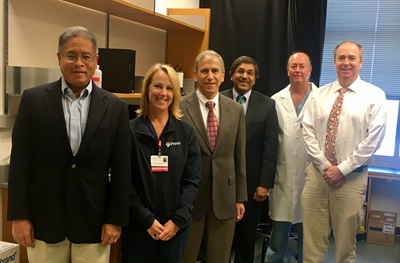
Penn Medicine Barrett’s Esophagus Translational Research Network Team, (L to R) Gary D. Wu, MD; Maureen DeMarshall, RN; Gary W. Falk, MD, MS; Anil K. Rustgi, MD; Gregory G. Ginsberg, MD; and John P. Lynch, MD, PhD.
PHILADELPHIA - A research group in the division of Gastroenterology in the Perelman School of Medicine at the University of Pennsylvania has received a National Cancer Institute grant to extend a Barrett's Esophagus translational research network with Columbia University and the Mayo Clinic until 2022. The total award is $6.5 million for all three sites. (The group has additional collaborators at MIT, the Dana Farber Cancer Institute, and Munich Technical University.)
The new award enables continuation of a research partnership that began in 2011 with an initial $8 million grant that formed a multidisciplinary, translational research program to study the origins and pathogenesis of Barrett's esophagus. The goal of phase two of the partnership is to advance knowledge of the role of the microbiome (microorganisms) and microenvironment in the development of Barrett's esophagus and esophageal adenocarcinoma, the highly lethal cancer associated with Barrett’s Esophagus. The researchers propose that the rapid rise in these two conditions is in part due to changes in the microbiome, leading to the development of a microenvironment conducive to the forming of tumors. Characterization of these changes could lead to predictive biomarkers and targets for intervention.
The esophagus is a tube that carries food from the mouth to the stomach. In Barrett's esophagus, esophageal tissue is replaced by tissue that looks and behaves more like small intestine tissue. Barrett's esophagus is caused by chronic gastroesophageal reflux disease (GERD). While the Barrett’s esophagus itself is well tolerated by patients, it is a significant risk factor for developing esophageal adenocarcinoma, which is of great concern for physicians and patients alike.
“We are grateful to the National Cancer Institute for this important continuation of funding,” said John Lynch, MD, PhD, an associate professor in the division of Gastroenterology and a member of the research team. “It will enable us to carry on our work with our partners, with the aim of converting our research findings into potential diagnosis, prevention, and treatment applications against this important disease.”
Co-principal investigators at Penn include Gary W. Falk, MD, MS a professor of medicine; Gregory Ginsberg, MD, a professor of medicine, and Anil K. Rustgi, MD, the T. Grier Miller professor of Medicine and chief of the division of Gastroenterology. The Columbia University Medical Center component of the partnership is led by Timothy Wang, MD, while the Mayo Clinic team is led by Kenneth Wang, MD.
In the new phase of the project, the researchers will focus on the role of microbiota (tens of trillions of microorganisms that live in the esophagus and human gut) and the tissue microenvironment in the development of Barrett's esophagus and its progression to esophageal adenocarcinoma. It is built around the hypothesis that the inflammation-dependent tumor microenvironment, modulated by the microbiome of the gastroesophageal (GE) junction (where the esophagus connects to the stomach), is critical for early progression of esophageal carcinogenesis.
The three projects will focus on studying the role of microbiota and blood-forming cells of the bone marrow (myeloid cells) in the L2-IL-1β mouse model of Barrett's esophagus and esophageal adenocarcinoma, characterizing microenvironmental factors in Barrett's esophagus and esophageal adenocarcinoma, and identifying novel biomarkers and gene signatures related to the microbiome and microenvironment.
“Overall, these three projects, integrated from the laboratory bench to the patient’s bedside, will advance the science of the microbiome and microenvironment in Barrett's esophagus,” said Lynch. “We expect our observations here will lead to new insights into how the disease develops and progresses to cancer, and likely result in novel translational applications, including new biomarkers and therapies.”
Esophageal adenocarcinoma is the fastest growing cancer in the United States; its five-year survival rate is 15 percent, yet our understanding of it lags well behind that of other cancers such as colon and breast cancer. The National Cancer Institute recognized this limitation and developed the BETRNet research program in 2011, to support multicenter, translational research into Barrett’s esophagus and esophageal adenocarcinoma.
Penn Medicine is one of the world’s leading academic medical centers, dedicated to the related missions of medical education, biomedical research, excellence in patient care, and community service. The organization consists of the University of Pennsylvania Health System and Penn’s Raymond and Ruth Perelman School of Medicine, founded in 1765 as the nation’s first medical school.
The Perelman School of Medicine is consistently among the nation's top recipients of funding from the National Institutes of Health, with $550 million awarded in the 2022 fiscal year. Home to a proud history of “firsts” in medicine, Penn Medicine teams have pioneered discoveries and innovations that have shaped modern medicine, including recent breakthroughs such as CAR T cell therapy for cancer and the mRNA technology used in COVID-19 vaccines.
The University of Pennsylvania Health System’s patient care facilities stretch from the Susquehanna River in Pennsylvania to the New Jersey shore. These include the Hospital of the University of Pennsylvania, Penn Presbyterian Medical Center, Chester County Hospital, Lancaster General Health, Penn Medicine Princeton Health, and Pennsylvania Hospital—the nation’s first hospital, founded in 1751. Additional facilities and enterprises include Good Shepherd Penn Partners, Penn Medicine at Home, Lancaster Behavioral Health Hospital, and Princeton House Behavioral Health, among others.
Penn Medicine is an $11.1 billion enterprise powered by more than 49,000 talented faculty and staff.